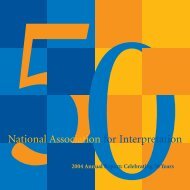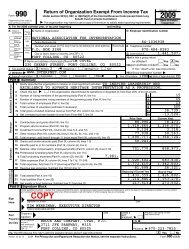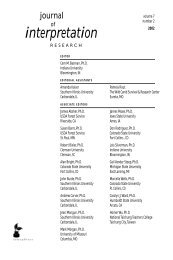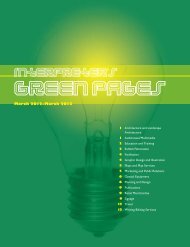interpretation
Volume 15, Number 1 - National Association for Interpretation
Volume 15, Number 1 - National Association for Interpretation
You also want an ePaper? Increase the reach of your titles
YUMPU automatically turns print PDFs into web optimized ePapers that Google loves.
t r o y e. h a l l , s a m h. h a m , b r e n d a k. l a c k e y<br />
Bitgood, S. (2000). The role of attention in designing effective interpretive labels. Journal<br />
of Interpretation Research, 5(2), 31–45.<br />
Block, L. G., & Keller, P. A. (1997). Effects of self-efficacy and vividness on the<br />
persuasiveness of health communications. Journal of Consumer Psychology, 6(1),<br />
31–54.<br />
Brosius, H.-B., & Bathelt, A. (1994). The utility of exemplars in persuasive<br />
communications. Communication Research, 21(1), 48–78.<br />
Campbell, R. G., & Babrow, A. S. (2004). The role of empathy in responses to persuasive<br />
risk communication: Overcoming resistance to HIV prevention messages. Health<br />
Communication, 16(2), 159–182.<br />
David, P. (1998). News concreteness and visual-verbal association: Do news pictures<br />
narrow the recall gap between concrete and abstract news. Human Communication<br />
Research, 25(2), 180–201.<br />
De Young, R., & Monroe, M. C. (1996). Some fundamentals of engaging stories.<br />
Environmental Education Research, 2, 171–187.<br />
Eagly, A. H., & Kulesa, P. (1997). Attitudes, attitude structure, and resistance to change:<br />
Implications for persuasion on environmental issues. In M. H. Bazerman, D. M.<br />
Messick, A. E. Tenbrunsel & K. A. Wade-Benzoni (Eds.), Environment, ethics, and<br />
behavior: The psychology of environmental valuation and degradation (pp. 122–153).<br />
San Francisco: New Lexington Press.<br />
Falk, J. H. (1997). Testing a museum exhibition design assumption: Effect of explicit<br />
labeling of exhibit clusters on visitor concept development. Science Education,<br />
81(6), 679–687.<br />
Falk, J. & Dierking, L. (1992). The museum experience. Washington, DC: Whalesback<br />
Books.<br />
Falk, J. & Storksdieck, M. (2005). Using the contextual model of learning to understand<br />
visitor learning from a science center exhibition. Science Education 89: 744–778.<br />
Garcia-Marques, T., & Mackie, D. M. (2001). The feeling of familiarity as a regulator of<br />
persuasive processing. Social Cognition, 19(1), 9–34.<br />
Hall, T. E., Hockett, K. S., & Smith-Jackson, T. (2001). Tests of small panel signs in<br />
Yosemite National Park (Unpublished Report). Blacksburg, VA: Virginia Tech.<br />
Ham, S. H. (1992). Environmental <strong>interpretation</strong>: A practical guide for people with big<br />
ideas and small budgets. Golden, CO: North American Press.<br />
Ham, S., & Weiler, B. (2005). Experimental evaluation of persuasive communication<br />
strategies aimed at influencing problem visitor behaviour at Port Campbell National<br />
Park. Final research report to Parks Victoria. Melbourne, Australia: Monash<br />
University, Tourism Research Unit.<br />
Ham, S. H., Weiler, B., Hughes, M., Brown, T. J., Curtis, J., & Poll, M. (2008). Asking<br />
visitors to help: Research to guide strategic communication for protected area<br />
management. Gold Coast: Sustainable Tourism Cooperative Research Centre.<br />
34 j o u r n a l o f i n t e r p r e t a t i o n r e s e a r c h












